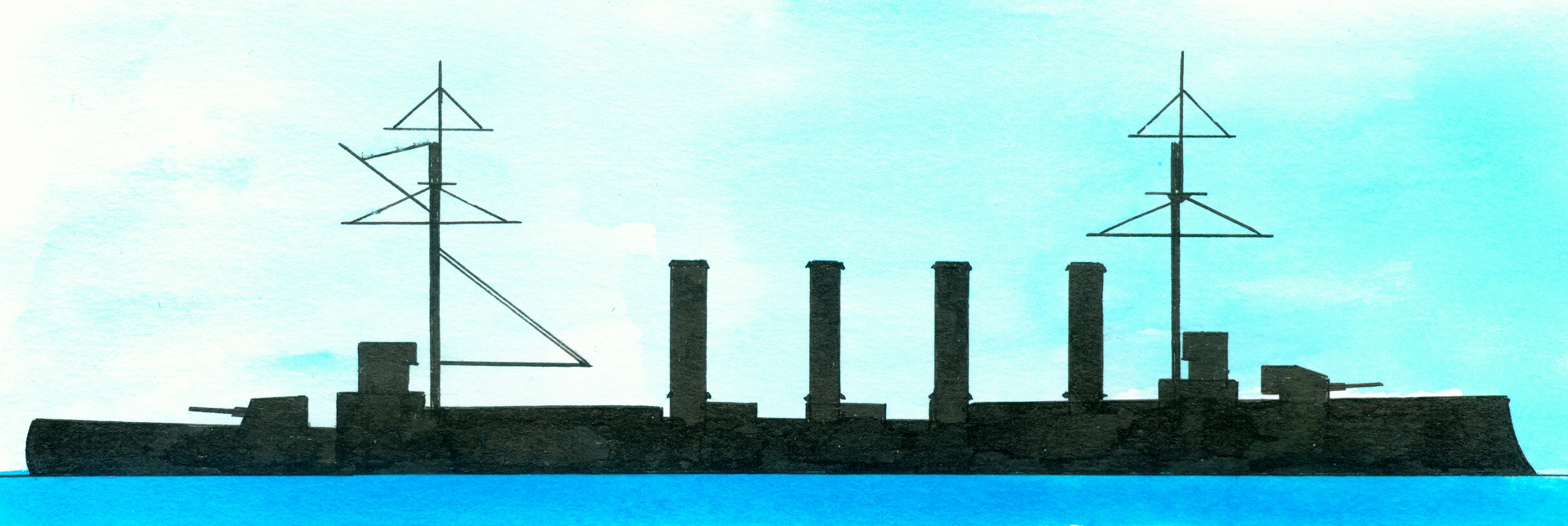Duncan-class battleships
Drake-class armoured cruisers
An item referred to the magazine Mittheilungen aus dem Gebiete des Seewesens reporting that the British battleship under construction at Hull, England was to be named Russell (1) and that at Birkenhead Exmouth.(2) Of the cruisers under construction was the one at Barrow to be named King Alfred (3), the one to be laid down at Pembroke Drake (4) and the ones at the Clyde Africa (5) and Leviathan.(6) The horsepower of the battleships and cruisers was to be respectively 18.000 and 30.000 ihp. All ships were fitted out with Belleville boilers.
Notes
1. Laid down by Palmers Shipbuilding and Iron Company, Jarrow on 11 March 1899, launched on 19 February 1901, completed in February 1903, commissioned on 19 February 1903 and sunk after striking mines laid by the German submarine U-72 off Malta on 27 April 1916. Building costs 1.104.051 pond sterling. Duncan-class consisting of the Duncan, Cornwallis, Montagu, Albemarle, Exmouth and Russell preceded by the London-class and succeeded by the King Edward VII-class. Designed as a British on the building programmes of France and Russia, the latter program including fast battleships. The Duncan-class was unofficially known as The Admirals.
2. Laid down at Laird Brothers, Birkenhead, England on 10 August 1899, launched on 31 August 1901, baptized by Lady Alice Stanley, completed in May 1903, commissioned on 2 June 1903,refitted at Portsmouth Dockyard between April- May 1917, refitted at Malta 1908-1909, commissioned reserve and used as gunnery training ship at Devonport since 1 July 1913, paid off at Devonport to supply sailors for the anti submarine vessels in August 1917, accommodation ship since January 1918, decommissioned and for sale n April 1919 and sold to the Forth Shipbreaking Company be broken up on 15 January 1920. She was broken up in the Netherlands. Building costs 1.098.159 pond sterling. Duncan-class consisting of the Duncan, Cornwallis, Montagu, Albemarle, Exmouth and Russell preceded by the London-class and succeeded by the King Edward VII-class. Designed as a British on the building programmes of France and Russia, the latter program including fast battleships. The Duncan-class was unofficially known as The Admirals.
3. Laid down at the shipyard of Vickers Limited, Barrow-in-Furness, England by the countess of Lathom on 11 August 1899, launched on 28 October 1901. Completed on 22 December 1903, torpedoed by the German submarine UB-86 north of Ireland on 11 April 1918, repaired at Liverpool, England and decommissioned again and finally sold to be broken up in the Netherlands on 30 January 1920. Building costs 978.125-1.013.772 pound sterling. Of the Drake-class consisting of the Drake, Good Hope, King Alfred and Leviathan preceded by the Cressy-class and succeeded by the Monmouth-class. In fact was this class an enlarged and improved Cressy-class design made by chief constructor Sir William White with as potential opponent the French armoured cruiser Jeanne d’Arc.
4. Laid down at the Pembroke Dockyard on 24 April 1899, launched by Mrs. Lort Phillips on 5 March 1901, completed on 13 January 1902, torpedoed by the German submarine U-79 around 5 miles off Rathlin Island, Northern Island and finally capsized on 22 October 1917. The wrecks partly salvaged since 1920 still exists nowadays. Building costs 1.002,977-1.050.625 pound sterling.
5. Laid down at the shipyard of Fairfield Shipbuilding&Engineering, Govan, Scotland on 11 September 1899, renamed Good Hope on 2 October 1900, launched on 21 February 1901, completed on 8 November 1902, added to the reserve in 1913, decommissioned in mid 1914 and sunk in the Battle of Coronel of the Chilean coast in a battle with the German East Asia squadron which included the large armoured cruisers Scharnhorst (1) and Gneisenau (2) on 1 November 1914. Building costs 990.759-1.023.629 pound sterling.
6. Laid down at the shipyard of John Brown&Company, Clydebank, Scotland on 30 November 1899, launched by Lady Inverclyde on 3 July 1901, completed on 16 June 1903, added to the reserve fleet in 1907, decommissioned in 1909, added to the reserve fleet on 1913, decommissioned in mid 1914, added to the reserve fleet in 1919 and finally sold to be broken up to Hughes Bolckow of Blyth, Northumberland on 3 March 1920. Building costs 1.012.959-1.043.097 pound sterling.


